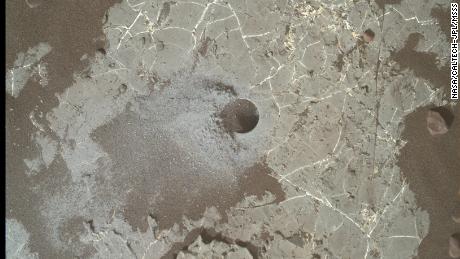A new analysis of sediment samples collected by the rover has revealed the presence of carbon – and the possible presence of ancient life on the Red Planet is just one possible explanation for why it’s there.
Therefore, carbon atoms – with their own recycling cycle – are trace elements of biological activity on Earth. So they can be used to help scientists determine if there was life on ancient Mars.
When these atoms are measured inside another material, such as Martian sediments, they can shed light on the planet’s carbon cycle, no matter when it occurred.
More information about the origin of this newly discovered Martian carbon may also reveal the carbon cycle on Mars.
Settlement secrets
Curiosity landed in Gale Crater on Mars in August 2012. The 96-mile (154.5 km) crater, named after Australian astronomer Walter F. Gale, was likely the result of a meteorite impact between 3.5 and 3.8 billion years ago. Great Bay may have contained a lake, and it now includes a mountain called Mount Sharp. The crater also contains layers of exposed old rock.
To take a closer look, a probe was drilled to collect sediment samples through the hole between August 2012 and July 2021. Curiosity then heated these 24 powder samples to about 1,562 degrees Fahrenheit (850 degrees Celsius) to separate the elements. This caused the samples to release methane, which was then analyzed by another instrument in the rover’s arsenal to show the presence of stable carbon isotopes, or carbon atoms.
In some samples, the carbon was depleted while others were enriched. Carbon has two stable isotopes, measured as carbon 12 or carbon 13.
“The 13 highly carbon-depleted samples are somewhat similar to Australian samples from 2.7 billion years of sediment,” House, the study’s lead author and professor of earth sciences at Penn State University, said in a statement.
“These samples were the result of biological activity when methane was consumed by ancient microbial mats, but we can’t necessarily say that on Mars because it is a planet that arose from materials and processes other than Earth.”
In lakes on Earth, microbes like to grow in large colonies, which basically form mats just below the surface of the water.
3 potential carbon sources
Different measurements of these carbon atoms could indicate three very different things about ancient Mars. The origin of the carbon is likely to be due to cosmic dust, ultraviolet decomposition of carbon dioxide, or ultraviolet decomposition of biologically produced methane.
According to the researchers, “all three of these scenarios are unconventional, in contrast to common processes on Earth.”
According to House, the first scenario is that our entire solar system passes through a galactic dust cloud, which occurs every 100 million years. Particle-laden clouds can cool rocky planets.
“There’s not much dust,” House said. “It’s hard to see any of these inclusion events in the Earth’s record.”
However, it is possible that during an event like this, a cosmic dust cloud lowered the temperature on ancient Mars, which could contain liquid water. This could cause glaciers to form on the surface of Mars, leaving a layer of dust on top of the ice. When the ice melts, a layer of sediment will remain, containing carbon. While it’s entirely possible, there is little evidence of glaciers at Gale Crater, and the study authors said more research is needed.
The second scenario involves converting carbon dioxide on Mars into organic compounds such as formaldehyde under the influence of ultraviolet radiation. This hypothesis also requires additional research.
The third method for producing this carbon has potential biological roots.
It is also possible that methane reacted with ultraviolet radiation, leaving a carbon footprint on the surface of Mars.
More pits on the horizon
Curiosity will return to the site where it collected most of the samples in about a month, which will provide another opportunity to analyze sediments from this interesting site.
“This research meets the long-term goal of exploring Mars,” House said. “To measure different carbon isotopes – one of the most important tools in geology – from sediments in a different habitable world, and this has been done over nine years of research.”

“Reader. Organizer. Infuriatingly humble twitter expert. Certified communicator.”




More Stories
Nvidia GeForce RTX 4090: AIDA64 gets Ada spearhead support
Rogue Trader – Details about the first cRPG in the series – CD-Action
t3n – Digital Pioneers | digital business magazine